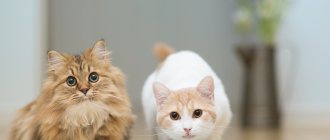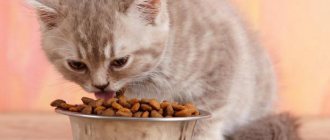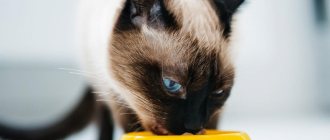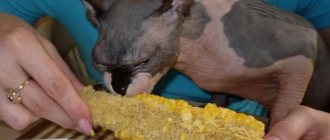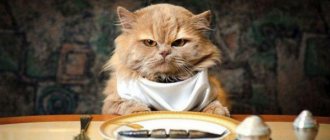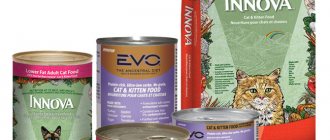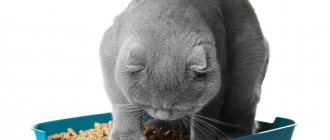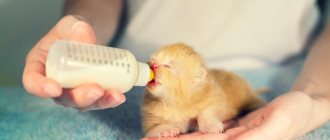Often people who have a cat and a dog at the same time are faced with the fact that their pets try each other’s food. This is normal, animals are simply not averse to “stealing” something tasty from a friend’s bowl. However, some owners are faced with a situation where the cat likes dog food and begins to eat it systematically.
Some people think that since the animal is happy with everything, then there is no need to take any action. Many people go further and buy only dog food for both pets. It usually costs less, which is an added incentive. However, a cat should not be given dog food; such food can cause various problems, since the food is intended for a different type of animal with different needs.
Relevance of the issue
Many cat owners today prefer to feed their pets prepared food. This makes life easier because it does not require the expense of searching and preparing food for the cat. It often turns out that store-bought food is cheaper than natural food.
If there are two or more animals of different species (cats and dogs) in the house, then some owners buy dog food and feed it to all pets. The fact is that dog food is often cheaper than similar cat food. In addition, the demand for dog food is lower, so retail chains and pet stores often run promotions on such products, offering significant discounts.
If we talk about treats and special devices for cleaning teeth that are given to animals to chew on, then such products are presented in a wide range in the dog version. Finding these types of treats for cats can be difficult. And the owner, sincerely confident that he wishes the cat well, gives her food for dogs.
Also, the relevance of the issue is that cats, simply by their nature, love to poke their nose into someone else's bowl. These animals are quite intelligent, and to think that they do not distinguish where whose food is is stupid. They all understand perfectly well. A cat can try dog food out of curiosity (what is it so tasty that I don’t have) or out of spite (look who’s boss), as well as for the purpose of theft (to realize the hunter’s instinct, to get prey). In addition, a cat may actually be attracted to the smell and taste of dog food and begin to prefer the neighbor's food. However, this situation cannot be allowed, since dog food is not intended for cats.
General information
In practice, if both a cat and a dog live in the house and are not fed in isolated areas, it is not uncommon for pets to calmly eat from each other’s bowls. Such cases are especially frequent if the food is of high quality and attracts both pets with its taste.
In such cases, the owner should be especially careful about the compatibility of dog food with the cat’s stomach.
Reasons why a cat doesn't eat as much from a dog's bowl:
- Current cat food is more sparse in content and the cat eats dog food because it suits her better.
- The cat is missing a specific ingredient in the dog's food.
- Dog food is fresher than what is currently offered to the cat.
Why cats can't eat dog food
Dog food is absolutely not suitable for cats, since different types of animals have different needs. Food manufacturers know this and develop products with this in mind.
Cats are predatory animals, and, despite living for a long time next to humans, their gastrointestinal tract continues to function according to the principles characteristic of obligate predators. This means that the basis of their diet should be meat, and the digestive tract does not accept carbohydrates and coarse plant fibers well. Cats have shorter intestines and lower digestive enzyme activity. That is, the body is adapted only to digest soft meat fibers.
In dogs, the need for animal proteins is much lower; their body perfectly absorbs carbohydrates and needs them.
Dog food most often contains a fairly high percentage of grains, from which they can obtain the substances necessary for energy production. The cat's body is not able to do this. Unlike omnivorous dogs, cats must receive animal protein. And if they eat exclusively dog food, they do not receive enough essential amino acids, which over time negatively affects their health.
A deficiency of two amino acids is especially dangerous for the body: taurine and arginine. If there is a lack of the former, cats develop hypertrophic cardiomyopathy - serious damage to the heart muscle, retinal atrophy, and deterioration of the condition of the teeth and coat. The lack of the second leads to disruption of the liver, as a result of which it cannot fully utilize toxic substances. This provokes a metabolic disorder - hyperammonemia, leading to ammonia intoxication in the body.
Food intended for dogs cannot provide a cat’s body with a sufficient amount of fatty acids. In particular, it does not receive enough arachidonic acid, without which the normal functioning of the reproductive, digestive and other body systems is impossible.
Physiological differences between dogs and cats
The cat is an obligate carnivore and feeds primarily on meat. She is more prone to frequent meals as she hunts small game. From the stomachs of victims, the pet can receive cereals, vegetables and fruits in a semi-digested form. They do not have any special nutritional value, but help the cat improve digestion.
Cats do not need grains: grains, of course, can be a source of fiber, but vegetables and fruits that additionally contain vitamins and minerals are preferable
The animal's feeding and hunting behavior are not synchronous. The pet can attack the victim without feeling hungry. Not all attempts of a cat to catch game end in success. If she only hunted when she was very hungry, she would most likely die due to exhaustion sooner or later. For this reason, pets are less prone to heavy meals. They may taste food and save it for later. Due to their physiological characteristics, cats have a faster metabolism.
In dogs, pack behavior predominates. Their regime is more orderly. Dogs hunt when necessary, and not to satisfy hunting instincts. Animals cope with hunger in another way: if there is no available meat food, they switch to a plant-based diet.
Wild relatives of dogs can also eat plant foods, but for wolves it is only an addition to the main menu
In addition, the fact of prolonged stay near a person affects the physiology of dogs. If cats are more independent and have retained most of their characteristics, then the shaggy companions have adapted to the diet that was offered to them. Dogs need less meat and tend to be omnivorous. There are cases when they were transferred to a vegetarian diet without critical health consequences. However, we do not recommend repeating such experiments: serious long-term studies on this matter have not yet been conducted. For one dog, a fruit and vegetable diet may be suitable, but for another, the same diet may be harmful.
Now I have 2 cats living at home. Before them there was a dog. I was clearly convinced of the differences between diets when, out of habit, I offered the cats apples. They are not contraindicated for them, they contain plant fibers, and a little vitamins will not hurt them. My dog adored apples, happily ate zucchini, eggplant and pumpkin, and even showed interest in citrus fruits, although he only received a few slices from time to time. Both cats sniffed the fruit, but refused the treat. They behave approximately the same way with most vegetables and fruits: at best, they try and leave. Dogs love to chew carrots and corn, eat berries with pleasure, and often prefer crackers to granulated food. Differences in diet suggest that professional formulations differ just as much.
Possible consequences
If a cat tries dog food, there is nothing wrong with that. Nothing will happen even if she does this periodically, based on some of her own considerations. It's still not poison for cats.
Situations in which she eats exclusively dog food should not be allowed. A cat must have its own diet; this is the only way to provide its body with all the substances necessary to maintain health.
Possible consequences of constant consumption of dog food by a cat:
- obesity developing due to excess carbohydrate consumption;
- anemia, decreased overall vitality due to a lack of essential amino acids;
- taurine deficiency, leading to disturbances in myocardial function and vision impairment;
- malfunction of the digestive system.
Convenient type of feeding
When preparing a diet for dogs, more and more owners prefer to use dry food. Indeed, this is very convenient for many reasons. The ritual of cooking does not require any hassle. And the portion, remaining uneaten, may well lie for some time so that its contents are consumed by the animal a little later. Therefore, if a cat looks into a dog bowl with leftover food, the owners usually do not see anything wrong with it, not always thinking about whether the cat can be given dog food. But carelessness often results in pet illnesses.
Careless bipeds can be understood. Mustachioed picky people with their whims and stubbornness are capable of forcing anyone to follow their lead. And while it’s easy to feed a dog, it’s much more difficult to please a cat. Largely for this reason, food for industrially produced dogs, being in less demand, is always more accessible. And even the most expensive dog food is usually cheaper than cat food. And owners, for the sake of convenience and economy, resign themselves to the preferences of their pets, allowing the cat to do what she likes.
How to wean a cat off dog food
Having noticed that the cat refuses the food intended for it and prefers food from the dog bowl, the owner should take action. The animal may not understand that what seems more attractive to it in taste and smell does not meet the needs of the body. The owner’s task is to reorient the cat towards healthy food specially developed for it.
Veterinarians and felinologists recommend the following:
- give pets food in different rooms, but at the same time, so the cat will have fewer temptations;
- remove dog food from the bowl 10 minutes after feeding (if there is anything left, because dogs usually eat the entire portion without trying to save it for later);
- if the dog is a large breed, then you can purchase a special stand for it, on which the bowl will be located just below the level of the mouth (for a cat, such a height will be inaccessible).
In addition, you should review your cat's diet. After all, the fact that she eats the dog’s food may indicate that her food simply does not suit her. You need to try offering her other brands of food: both dry and wet.
In no case should a cat be given dog food if a person cares about the health of his pet. You should not give it even as a joke or as an experiment. This will make the owner’s life easier and save him from possible financial costs for treating the animal in the future.
Details
Causes
On the part of the owner, there are also reasons that make you think about changing cat food to a dog equivalent:
- Dog food is easier to buy.
- The price per kilo is often lower than the price of cat food.
- There are often promotions on dog food.
But all these benefits are superficial. A cat can eat dog food with great pleasure, but problems with such food will manifest themselves over time. Any diet has a cumulative effect and sooner or later it will give its results and all the shortcomings will appear.
What happens if you feed a cat dog food?
- Obesity. Dogs require more carbohydrates than cats. As a result, the calories unspent during the day simply settle in the cat’s fatty tissue, gradually leading to excess weight and obesity.
- Lack of protein. Cats require more protein in their food than dogs. This is due to the fact that a cat is a predator, and a dog is an omnivore. Protein imbalance in the diet has a negative effect on the building of muscle tissue in cats.
- Deterioration of vision and disruption of the heart. The most important component of wet or dry cat food is taurine. This is a vital amino acid for the cat's body. It is simply not found in dog food, since this component is useless to dogs.
- Malfunctions of the gastrointestinal tract. It's no secret that dogs eat more plant fiber than cats. As a result, dry food also contains more of them, and often contains grains and vegetables that are beneficial for dogs and harmful for cats.
- Skin diseases. Dog food has a fat component that is not suitable for vitamins. Cats may be deficient in a number of nutrients that dogs do not need.
- Anemia. Dogs should not eat chicken eggs, for them it is a source of unnecessary cholesterol, but eggs, on the contrary, are beneficial for cats, as they contain many amino acids. Therefore, the composition of dog food often differs from cat food precisely in the set of amino acids.
- The ratio of vitamins for cats and dogs in food has different norms, which leads to a general imbalance in the animal’s nutrition.
- Not all components of dog food are digestible by cats. Even super premium dog food may not be digested properly in a cat's stomach.
IMPORTANT: dogs should not be fed cat food for the same reason that the composition is different.
It must be remembered that all of the above problems only apply to healthy cats who eat food from a dog bowl, which in turn is not intended to solve specific problems.
All the troubles from inappropriate nutrition are intensified if the cat has health problems, and the dog food has a special purpose. In such cases, the imbalance in nutrition is even more pronounced and the negative consequences appear faster and in a more serious form.
It's okay if your cat occasionally eats a couple of dog food pellets. On a non-permanent basis, such weakness can be tolerated. You should not feed your cat dog food on a regular basis.
Cases when you can give your cat dog food
- Wet food in the amount of 1 teaspoon can be given in cases where the cat refuses to eat its food and persistently climbs into the dog’s bowl. By gradually reducing the dose, you will wean the cat from eating food that is not its own. At the same time, the feeding places of both furry household members should be distinguished.
Dry dog food for small breed dogs can be given to a cat during training. But this method should only be used if the cat already knows what a particular dog food is and she likes it much more than her usual diet.
- If the food is monocomponent holistic, then in rare cases a large can can be divided between a dog and a cat.
IMPORTANT: if your cat has a weakness for dog food, then you should allow her to eat it no more than once every 2 weeks. Or add a few granules to a bowl of cat food so that the animal eats it for company, but again, no more than once a week.
General recommendations for feeding cats with industrial food
Industrial feeds are gaining increasing popularity. Of course, such products have a lot of advantages, but there are also disadvantages. An alternative to food is a natural diet, that is, buying food and regularly preparing food separately for the cat. Owners with busy work schedules cannot always find time to cook and switch their cat to industrial feeding.
It doesn’t really matter what type of food you give your pet, dry or wet, all industrial products are divided into classes :
- Economy is the cheapest segment and is not recommended for constant feeding of animals. The products often contain soy, corn, and carcass residues (referred to as blended meats or protein residues).
- Premium – everyday food for healthy animals. Some brands do not contain a full spectrum of vitamins; also, meat products are replaced with a surrogate (bone meal, leftovers from carcasses).
- Super-premium – logically, optimal and fully fortified daily food for healthy cats. However, don’t be lazy and read the ingredients on the package. All ingredients must be clearly stated, without vague wording.
- Holistic is the highest quality food, close to the natural composition. The holistic class also includes medicinal foods that are prescribed to cats with food allergies, urolithiasis and other pathologies.
Note! If we are talking about food of the same brand and line, the composition and quality of the dry and wet product should not differ.
There is competition on the owner's side; manufacturers are forced to maintain the quality of their product at the proper level...or disguise it with advertising. It’s interesting that the so-called economy food is not much cheaper than the premium class, and all because much more money is spent on advertising the former.
When choosing between dry, semi-moist and pate food, they often choose granules.
There are several reasons:
- Better to store.
- You can leave it in the bowl all day - by the way, it is recommended to feed cats on a schedule. If you cannot maintain a feeding schedule, it is better to purchase an automatic feeder. If you leave your cat with a full bowl of food all day, you will soon be faced with a problem - obesity in your pet.
- Cheaper.
- Easier to dose.
The cats' reaction suggests otherwise. They happily eat wet food and pates. The reason is the smell and texture; the cat prefers aromatic, moist and warm food. What are the disadvantages of dry food? The obvious disadvantage is tooth decay, since meat is a cat's natural food. The enamel on an animal's teeth protects the teeth, which are meant to cut rather than crush food.
If your cat only receives kibble, she may experience constipation and indigestion. Not long ago it became known that cats do not suffer from addiction to food, and the difficulties with switching to natural food are related to physiology. The fact is that the gastrointestinal tract “gets used” to the granules and loses the ability to digest natural food. For this and a number of other reasons, dry food cannot be mixed with natural food and suddenly replaced with it.
Important! When feeding dry food, your cat's need for water increases dramatically! Make sure that the drinking bowl is always within your pet's reach and filled with fresh water.
A lot has been said about the quality of food, it’s time to reveal the subtleties by which each owner can determine how healthy the chosen product is. The first thing you should pay attention to is authenticity. Many foods of well-known brands are produced under patents, and the analogue is almost always inferior in quality to the original. A product officially launched on the market has certain obligations regarding the design of the pack, namely: placement of the full composition, barcode, manufacturer and distributor data.
Let us repeat about the composition, it should be understandable to the common man; complex terms are usually used to hide undesirable components. Don't forget to check the expiration date and try not to buy food that is sold by weight.
How to choose cat food?
There are several basic rules that allow you to narrow your choice to a minimum. When deciding to keep your cat on mixed food, avoid common mistakes. Select products according to your needs and age. Adult cats do not need to be given kitten food. Healthy animals do not need medicated food; moreover, it can have a negative impact on the pet’s well-being.
Be sure to consider the energy value of the feed. Cats don't need a lot of carbohydrates. The diet should contain mainly proteins, and its calorie content should fluctuate in the range of 80–90 Kcal per 100 g. product.
Important! No manufacturer produces universal food for dogs and cats! If you see such products, feel free to avoid them.
Taurine and arginine
These are essential amino acids for the cat’s body; if they are deficient, serious and dangerous conditions develop not only for the health, but also for the life of the pet. Taurine is contained in large quantities in the retina of a cat’s eye, and therefore, with its chronic deficiency, vision primarily suffers, and over time the animal inevitably goes blind. In addition, taurine is extremely important for the cardiovascular and nervous systems, blood clotting, reproductive and gastrointestinal function, and much more.
Arginine is no less important; if it is deficient, ammonia accumulates in the blood, which can have fatal consequences.
Vitamin A
It is a fat-soluble vitamin found in animal products. Cats do not have an enzyme that can convert vitamin A from beta-carotene, so they cannot get it from carrots or other carotene-rich vegetables. With a lack of animal products in the diet, vitamin A deficiency occurs, which primarily affects the animal's vision, skin and fur.
As we can see, feeding cats dog food all the time means ruining their health, and therefore you should definitely choose your pet’s own high-quality diet, which contains all the vitamins and nutrients it needs.
